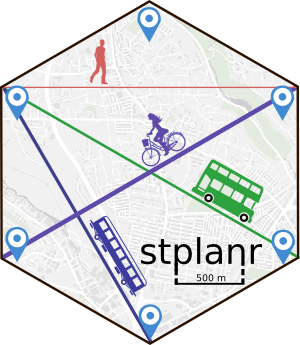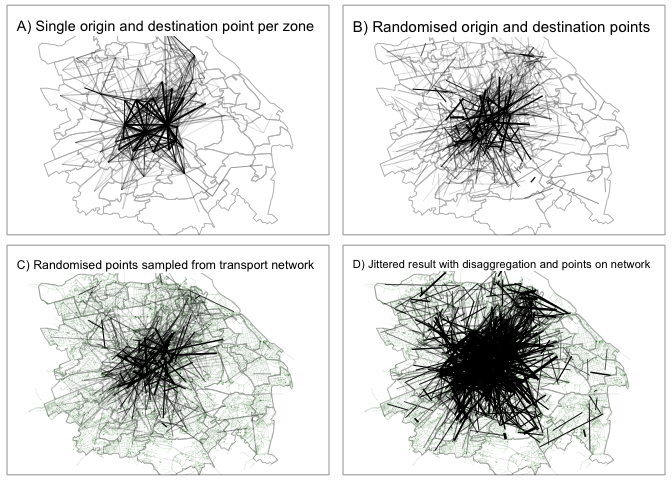Jittering and routing options for converting origin-destination data into route networks
Towards accurate estimates of movement at the street level
Robin Lovelace, University of Leeds +Rosa Félix, Dustin Carlino
ITS Leeds 2022-10-19
Background
- We need to build dense walking/cycling/wheeling networks
- But where?

Source: Cycle Routing Uptake and Scenario Estimation (CRUSE) tool
Tools of the trade



Tools of the trade




- Need for more sustainable transport systems
- Local authorities need data
- We've developed a number of tools that provide this data
What is Jittering?

Source: Lovelace, R., Félix, R., & Carlino, D. (2022, January 13). Jittering: A computationally efficient method for generating realistic route networks from origin-destination data. Transport Findings, in Press https://doi.org/10.31219/osf.io/qux6g
Current default: centroid-based desire lines (+routes+rnets)

Jittering in action: minimal reproducible example

Jittering a larger dataset
Adding value and detail to existing OD data. Source: Lovelace, Félix and Carlino (2022)

Resulting route network

Validating the approach: MKI
Data from Edinburgh. Source: GISRUK 2022 conference paper.

See slides here
Model experiments: jittering parameters

Results From Edinburgh

Changing jittering and routing params
The 'jittering only' approach is assumes perfect routing, not true
Model/data discrepancies may be more due to routing than jittering/OD parameters
Enter Lisbon!

Network level results

Summary of results

Using the results: biclar project
- Project funded by Lisbon Metro Region's Department for Transport (population: 2.8m)
- Need for evidence to support effective investment in cycle plans
- Current level of cycling regionally: 0.5%
- Targets: at least 4% by 2025 and 10% of trips by 2030 with shift coming from cars
- Comparison with UK: ~doubling from 2013 to 2025 in cycling
- from "0.8 billion stages in 2013 to 1.6 billion stages in 2025" (CWIS, 2017)
Biclar: approach
- R package and open source code base building on PCT approach
- See https://u-shift.github.io/biclar/

Existing and simulated network


Which trips will shift?

Next steps
Exploring the parameter space: different origin and destination points + weights, routing 'engines', disaggregation.
Selection of input data: open options
- Estimates of cyclability (hackathon at 15:00 today)
- Traffic count data
- Urban Observatory type data (Newcastle, Birmingham, Manchester)
- Faceboook and Google open mobility data
- 'OSM2od' - spatial interaction model
- Modelled data
- jittering: spatial disaggregation
- temporal disaggregation
Non-open data data
- National Travel Survey
- Mobile Telephone Data
- Large GPS type data (biobank, Google timeline, Straval)
References
Cyclability hackathon at 15:00 today: https://github.com/itsLeeds/cyclability
Biclar project and open source codebase: https://u-shift.github.io/biclar/
Carlino, Dustin, et al. A/B Street. Zenodo, 2022, https://doi.org/10.5281/zenodo.6331922.
Lovelace, Robin, et al. Exploring Jittering and Routing Options for Converting Origin-Destination Data into Route Networks: Towards Accurate Estimates of Movement at the Street Level. June 2022, https://doi.org/10.5194/isprs-archives-XLVIII-4-W1-2022-279-2022.
Lovelace, Robin, et al. “Jittering: A Computationally Efficient Method for Generating Realistic Route Networks from Origin-Destination Data.” Findings, Apr. 2022, p. 33873, https://doi.org/10.32866/001c.33873.
Appendix: Reproducible code I: Rust implementation
See reproducible repo + manuscript here: https://github.com/Robinlovelace/odnet
System command line implementation (compile Rust code):
cargo install --git https://github.com/dabreegster/odjitterodjitter jitter --od-csv-path od_iz_ed.csv \ --zones-path iz_zones11_ed.geojson \ --subpoints-path road_network_ed.geojson \ --max-per-od 10 --output-path output_max50.geojsonReproducible code II: R implementation
(See code in slides.Rmd in robinlovelace/foss4g22 for code to get data)
remotes::install_github("dabreegster/odjitter", subdir = "r")od = read_csv("od_iz_ed.csv")zones = sf::read_sf("iz_zones11_ed.geojson")od_jittered = odjitter::jitter( od = od, zones = zones, subpoints = sf::read_sf("road_network_ed.geojson") )od_jittered2 = odjitter::jitter( od = od, zones = zones, subpoints = sf::read_sf("road_network_ed.geojson"), disaggregation_key = "all", disaggregation_threshold = 10 )Results of reprex 1
od_sf = od::od_to_sf( od, zones)nrow(od_sf)## [1] 10394nrow(od_jittered)## [1] 10394nrow(od_jittered2)## [1] 22432Plot of unjittered data
library(dplyr)plot(od_sf$geometry, lwd = od_sf$all / 500)
Results of reprex 2
plot(od_jittered$geometry, lwd = od_jittered$all / 500)
Results of reprex 3
plot(od_jittered2$geometry, lwd = od_jittered2$all / 50)
Reproducible example
u = "https://github.com/ITSLeeds/od/releases/download/v0.3.1/od_intra_top_sf.geojson"desire_lines_oa_wpz_1k = sf::read_sf(u)oas_in_buffer = sf::read_sf("https://github.com/ITSLeeds/od/releases/download/v0.3.1/oas_in_buffer.geojson")wpz_in_buffer = sf::read_sf("https://github.com/ITSLeeds/od/releases/download/v0.3.1/wpz_in_buffer.geojson")library(tmap)tmap_mode("view")## tmap mode set to interactive viewingm = tm_shape(desire_lines_oa_wpz_1k) + tm_lines() + tm_shape(oas_in_buffer) + tm_dots(col = "darkgreen") + tm_shape(wpz_in_buffer) + tm_dots(col = "darkred")See here for map


 Source: Morgan and Lovelace (
Source: Morgan and Lovelace (
